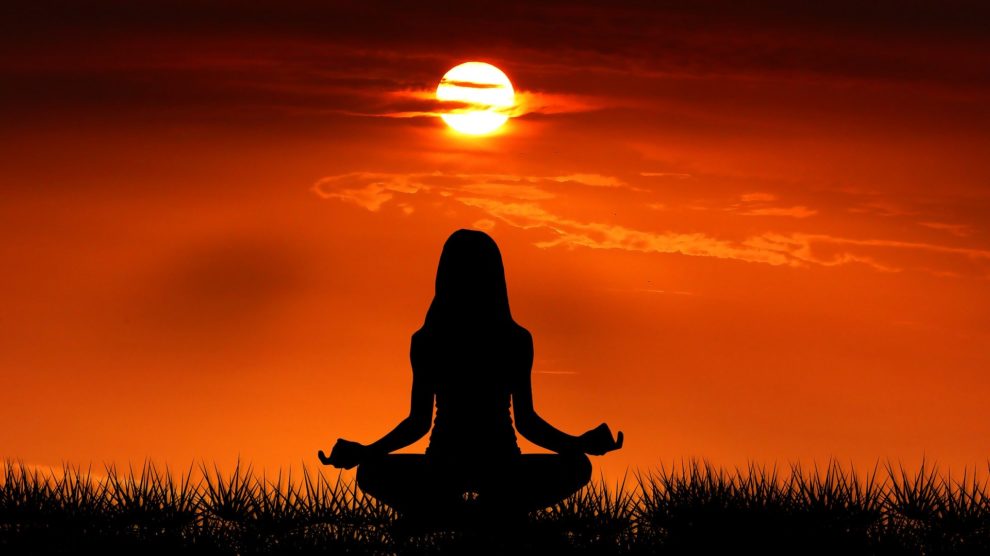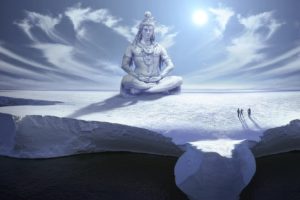FROM SATGURU BODHINATHA VEYLANSWAMI
Spiritual life can be likened to climbing a mountain. Each experience offers opportunities to progress toward the peak, which represents illumination and union with the Divinity that lies within us. The inner climb to that spiritual summit depends, like earthy mountain climbing, on rigorously applying proven methods, called sadhana in Sanskrit.
Sadhana refers to disciplines undertaken to reach a specific spiritual goal–steady and persevering practice of a method or exercise prescribed for spiritual ends. Of course, goals vary widely among the different Hindu traditions. Wikipedia’s explanation of sadhana’s goals highlights that diversity: “enlightenment, pure love of God, liberation from the cycle of birth and death, or a particular goal such as the blessings of a Deity, as in the bhakti traditions.” The idea of employing various means of spiritual accomplishment and thereby moving closer to the goal of God realization is appealing to all devout Hindus. On the other hand, the demands of modern life–work, school and commute time–give many the sense that there is not enough time to fit spiritual practice into an already overly busy schedule. Many pilgrims to our monastery confide to me they are caught in this dilemma. My advice is to establish a daily vigil, even if it is just 15 minutes, preferably in the morning, before you are caught up in your day. Try it for two weeks and see how it works out. Make it a habit, an appointment with yourself. Those who establish a daily vigil find that it makes them more efficient, more centered, more patient, more content and more productive. So it is time well spent! Once a strong habit is established, it becomes not only easy, but the day’s most important appointment. The nature of your sadhana routine is up to you and your guru. It is your island of quiet, a time to worship the Divine, perform puja, do yoga, study scripture and get in touch with your innate Divinity. And, like anything else, the more effort you put into your vigil and the more consistent you are, the greater the benefits will be.
Satguru Bodhinatha Veylanswami
Discipline for Self-Transformation
An Inspired Talk Given by Satguru Sivaya Subramuniyaswami to a Gathering of Devotees
When we study and practice our religion, we are not necessarily performing deep sadhana. We are simply dispatching our religious duties. The performance of personal sadhana, discipline for self-transformation, is one step deeper in making religion real in one’s life. Through sadhana we learn to control the energies of the body and nerve system, and we experience that through the control of the breath the mind becomes peaceful. Sadhana is practiced in the home, in the forest, by a flowing river, under a favorite tree, in the temple, in gurukulas or wherever a pure, serene atmosphere can be found. A vrata, vow, is often taken before serious sadhana is begun. The vrata is a personal pledge between oneself, one’s guru and the angelic beings of the inner worlds to perform the disciplines regularly, conscientiously, at the same time each day.
Establishing Your Sadhana
Who sets the course of sadhana? The course of sadhana can be set by an elder of the Hindu community. It can also be set by one’s satguru. Your mother and father, who are your first gurus, can also set the course of sadhana for their children. Or it can be set by yourself, from a book. There are many fine books available outlining the basics of yoga, sadhana and meditation.
Where does sadhana begin? It begins within the home, and it begins within you. This is ancient wisdom recognized not only in India, but among many great civilizations of history. Thus upon the wall of a famous ancient Greek temple and oracular center at Delphi was inscribed “Know thyself.” The religion of the Greeks, which was in many respects not unlike Hinduism, is long since gone, but remaining temple ruins testify to its magnificence. By disciplining your mind, body and emotions through sadhana, you come more and more into the inner knowing of yourself.
You will first discover that when the breath is regulated, it is impossible for the thinking mind to run wild, and when the breath is slightly held, it is impossible for more than one thought to remain vibrating in the mind at a time. You will experience that when the nerve currents are quieted through diaphragmatic breathing, it is impossible to be frustrated, and it is possible to absorb within yourself, into the great halls of inner learning, into the great vacuum within you, all of your problems, troubles and fears, without having to psychoanalyze them.
Through the regular practice of scriptural study, which is a vital part of your daily sadhana vigil, you will soon find that it is possible to touch into your subsuperconscious mind and complement that study with your own inner knowing. After you are well established in your sadhana, you will enjoy a greater ability to discipline your body, your breath, your nerve system and your mind.
We first have to learn that in order to control the breath, we have to study and understand the breath, the lungs, how the body is constructed and how the pranas move through it. This enables us to understand the subtle system within the body that controls the thinking mind. Then we are ready to study the mind in its totality.
The Five States of Mind
The conscious mind is our external mind. The subconscious mind contains our memory patterns and all impressions of the past. The sub of the subconscious mind holds the seeds of karmas that are not yet manifest. The subsuperconscious mind works through the subconscious mind, and intuition flows daily as a result. Creativity is there at your bidding. Your superconscious mind is where intuitive flashes occur. The accomplished mystic can consciously be in one country or another instantaneously, according to his will, once he has, through the grace of Lord Siva, attained a full inner knowing of how to remain in Satchidananda, the superconscious mind, consciously, without the other states interfering.
Consistency Is the Key
Yes, sadhana begins in the home, and it begins with you. It must be practiced regularly, at the same time each day–not two hours one day, one hour the next and then forgetting about it for three or four days because you are too busy with external affairs, but every day, at the same time. Meeting this appointment with yourself is in itself a sadhana. In the technological age nearly everyone finds it difficult to set one hour aside in which to perform sadhana. This is why in your sadhana vrata, or vow, you promise to dedicate only one half hour a day. In the agricultural era, it was easy to find time to perform sadhana two to three hours a day. Why? The demands of external life were not as great as they are now, in the technological age.
Brahmacharis and brahmacharinis, celibate men and women, in their respective gurukulas dedicate their time to the performance of sadhana. They rise together early in the morning, perform their sadhana as a group, and then are off to their daily work. The regular practice of sadhana, they have found, enables them to get along admirably well with one another because of their newly acquired abilities of absorbing their difficulties, thus avoiding argument and confrontation. In these gurukulas, found worldwide, various kinds of sadhanas are performed, such as scriptural study, chanting the names of the Lord on the japa beads, group chanting of bhajanas, the singing of Devarams and the yogic concentration of holding the mind fixed on one point and bringing it back to that one point each time it wanders. The more disciplined gurukulas religiously administrate group sadhana at the same time each day, every day without fail. Daily life revolves around this period of sadhana, just as in a religious Saivite home life revolves around the shrine room and each one’s daily personal vigil.
What Comes First in Your Life?
Ask yourself what you put first in your daily life. Do your emotions come first? Does your intellect come first? Do your instinctive impulses come first? Does your striving to overcome worries and fears and doubt come first inside of you? Does your creativity, your love for all humanity, your search for God and peace within yourself come first inside of you? What are your priorities?
Questions and Challenges
When you first begin your daily sadhana, it is likely to begin in an awkward way, and you may come to know yourself in a way that you don’t want to know yourself. Don’t be discouraged when the mind runs wild as you sit quietly and are unable to control it. Don’t be discouraged if you find that you are unable to even choose a time to sit quietly for one-half hour on a regular daily basis. If you persist, soon all this will be overcome and a firmness of mind will be felt, for it is through the regular practice of sadhana that the mind becomes firm and the intellect pure. It is through the regular practice of concentration that awareness detaches itself from the external mind and hovers within, internalizing the knowledge of the physical body, the breath and the emotions. Concentration of the forces of the body, mind and emotions brings us automatically into meditation, dhyana, and into deeper internalized awareness.
The spiritual practice should be reasonable, should not take up too much time, and should be done at the same time every day. Often seekers who become associated with Hindu sadhana go to extremes and proceed with great vigor in an effort to attain results immediately. Sitting two or three hours a day, they wear themselves out and then stop. Here’s a formula for beginners: Monday, Tuesday, Wednesday, Thursday, Friday, twenty minutes to a half an hour of sadhana at the same time every day; Saturday and Sunday, no sadhana.
The keys are moderation and consistency. Consistency is the key to the conquest of karma. If you go to extremes or are sporadic in your sadhana, you can easily slide backwards. What happens when you slide backwards? You become fearful, you become angry, you become jealous, you become confused. What happens when you move forward? You become brave, you become calm, you become self-confident and your mind is clear.
The Benefits of Sadhana
It is often feared that meditation and religious devotion cause a withdrawal from the world. The practice of sadhana I have described does not detach you from or make you indifferent to the world. Rather, it brings up a strength within you, a shakti, enabling you to move the forces of the world in a positive way. What is meant by “moving the forces of the world”? That means fulfilling realistic goals that you set for yourself. That means performing your job as an employer or as an employee in the most excellent way possible. That means stretching your mind and emotions and endurance to the limit and therefore getting stronger and stronger day by day. You are involved in the world, and the world is in a technological age.
The sadhana that you perform will make your mind steady and your will strong so that you can move the forces of the physical world with love and understanding, rather than through anger, hatred, antagonism, cunning, jealousy and greed. Daily sadhana performed in the right way will help you overcome these instinctive barriers to peace of mind and the fullness of being. If you have children, the rewards of your sadhana will help you educate your children properly in fine schools and universities and see that all of their physical needs are met through the flow of material abundance that automatically comes as you progress in your inner life.
Through daily sadhana we shall come to know the body, we shall come to know the emotions, we shall come to know the nerve system, we shall come to know the breath, and we shall come to know the mind in its totality. Each one of you will soon be able to mentally pick up all of the dross of your subconscious, throw it within, into the great cavity of inner knowing at the feet of the Gods, there to be absorbed, dissolved and disappear. All this and more can be unfolded from within each one of you through your daily practice of sadhana. Sadhana is one of the great boons given to us in our religion.
When the devas within your home see you performing your sadhana each day, they give you psychic protection. They hover around you and keep away the extraneous thought forms that come from the homes of your neighbors or close friends and relatives. They all mentally chant “Aum Namah Sivaya,” keeping the vibration of the home alive with high thoughts and mantras so that the atmosphere is scintillating, creating for you a proper environment to delve within yourself. The fact that the devonic world is involved is one more good reason why you must choose a specific time for sadhana and religiously keep to that time each day, for you not only have an appointment with yourself but with the devas as well.
Experiential Religion
By performing the pancha nitya karmas (five obligatory duties), living the yamas and niyamas (cardinal virtues) to the best of your ability and performing your daily sadhana, your religion becomes closer and closer to you in your heart. You will soon begin to find that God Siva is within you as well as within the temple, because you become quiet enough to know this and experience that Lord Siva’s superconscious mind is identical to yours; there is no difference in Satchidananda. From this state, you will experience the conscious mind as “the watcher” and experience its subconscious as the storehouse of intellectual and emotional memory patterns. In daily life you will begin to experience the creativity of the subsuperconscious mind, as the forces of the First World are motivated through love as you fulfill your chosen dharma in living with Siva.
Thus our religion is an experiential religion, from its beginning stages to the most advanced. You have already encountered the magic of the temple, and you have had uplifting experiences within your home shrine. Now, as you perform your sadhana, you will enjoy spiritual experiences within yourself on the path of self-transformation.
It is up to you to put your religion into practice. Feel the power of the Gods in the puja. If you don’t feel them, if you are just going through ritual and don’t feel anything, you are not awake. Get the most out of every experience that the temple offers, the guru offers, the devas offer, that your life’s experiences, which you were born to live through, offer. In doing so, slowly the kundalini begins to loosen and imperceptibly rise into its yoga. That’s what does the yoga; it’s the kundalini seeking its source, like the tree growing, always reaching up to the Sun.
It is up to you to make the teachings a part of your life by working to understand each new concept as you persist in your daily religious practices. As a result, you will be able to brave the forces of the external world without being disturbed by them and fulfill your dharma in whatever walk of life you have chosen. Because your daily sadhana has regulated your nerve system, the quality of your work in the world will improve, and your mood in performing it will be confident and serene.
When your sadhana takes hold, you may experience a profound calmness within yourself. This calmness that you experience as a result of your meditation is called Satchidananda, the natural state of the mind. To arrive at that state, the instinctive energies have been lifted to the heart chakra and beyond, and the mind has become absolutely quiet. This is because you are not using your memory faculty. You are not using your reason faculty. You are not trying to move the forces of the world with your willpower faculty. You are simply resting within yourself. Therefore, if you are ever bothered by the external part of you, simply return to this inner, peaceful state as often as you can. You might call it your “home base.” From here you can have a clear perception of how you should behave in the external world, a clear perception of your future and a clear perception of the path ahead. This is a superconscious state, meaning “beyond normal consciousness.” So, simply deepen this inner state by being aware that you are aware.
Control of the Pranas
A great flow of prana is beginning to occur among the families of our congregation worldwide because each one has decided to discipline himself or herself and the children to perform sadhana. That brings the prana under control. If the prana is not under the control of the individual, it is controlled by other individuals. The negative control of prana is a control, and positive control of prana is a control. That’s why we say, “Seek good company,” because if you can’t control your prana, other people who do control their pranas can help you. The group helps the individual and the individual helps the group. If you mix with bad company, then the pranas begin to get disturbed. Once that happens, your energies are like a team of horses out of control. It takes a lot of skill and strength on the part of the individual to get those pranas back under control.
The control of prana is equally important on the inner planes. When you leave the physical body, you are in your astral body, your subtle body. It is not made of flesh and bones like your physical body–as the Buddhists say, “thirty-two kinds of dirt wrapped up in skin.” The astral body is made of prana. It floats. It can fly. It’s guided by your mind, which is composed of more rarefied prana, actinic energy. Wherever you want to go, you’ll be there immediately. And, of course, you do this in your sleep, in your dreams and after death. Many of you have had astral experiences and can testify how quickly you can move here and there when your astral body is detached from the physical body. However, if you don’t have control of your prana, you don’t have control of your astral body. Then where do you go when you drop off your physical body at death? You are magnetized to desires, uncontrollably magnetized to fulfilling unfulfilled desires. You are magnetized to groups of people who are fulfilling similar unfulfilled desires, and generally your consciousness goes down into lower chakras. Only in controlling your astral body do you have conscious control of your soul body, which is, of course, living within the astral body and resonating to the energy of the higher chakras.
My satguru, Siva Yogaswami, spoke of Saivism as the sadhana marga, “the path of striving,” explaining that it is a religion not only to be studied but also to be lived. “See God everywhere. This is practice. First do it intellectually. Then you will know it.” He taught that much knowledge comes through learning to interpret and understand the experiences of life. To avoid the sadhana marga is to avoid understanding the challenges of life. We must not fail to realize that each challenge is brought to us by our own actions of the past. Yes, our actions in the past have generated our life’s experiences today. All Hindus accept karma and reincarnation intellectually, but the concepts are not active in their lives until they accept the responsibilities of their own actions and the experiences that follow. In doing so, no blame can fall upon another. It is all our own doing. This is the sadhana marga–the path to perfection.
The sadhana marga leads us into the yoga pada quite naturally. But people don’t study yoga. They are not taught yoga. They are taught sadhana, and if they don’t perform it themselves–and no one can do it for them–they will never have a grip strong enough over their instinctive mind and intellectual mind to come onto the yoga marga, no matter how much they know about yoga. So, we don’t learn yoga. We mature into it. We don’t learn meditation. We awaken into it. You can teach meditation, you can teach yoga, but it’s all just words unless the individual is mature and awake on the inside.
To be awake on the inside means waking up early in the morning. You woke up early this morning. That may have been difficult. But you got the body up, you got the emotions up, you got the mind up, and your instinctive mind did not want to do all that. Did it? No! Spiritual life is a twenty-four-hour-a-day vigil.
Sadhana and Life’s Stages
Devotees who are doing sadhana and who are in the grihastha ashrama, between age twenty-four and forty-eight, should move the forces of the world rightly, dynamically, intelligently, quickly and make something of their lives. Such devotees should not be stimulated by competition. In today’s world most people have to be stimulated by competition to produce anything worthwhile, even if that means hurting other people. They have to be stimulated by conflict to produce anything worthy of producing in the world, and that hurts other people. They have to be stimulated by their home’s breaking up, and that hurts other people. And they have to be stimulated by all kinds of other lower emotions to be able to get enough energy to move the forces of the world to do something, whether it be good or bad. Those who perform sadhana draw on the forces of the soul to move the forces of the world and make a difference.
It is during the latter stages of life that family devotees have the opportunity to intensify their sadhana and give back to society of their experience, their knowledge and their wisdom gained through the first two ashramas. The vanaprastha ashrama, age forty-eight to seventy-two, is a very important stage of life because that is the time when you can inspire excellence in the brahmacharya students and in the families, to see that their life goes along as it should. Later, the sannyasa ashrama, beginning at seventy-two, is the time to enjoy and deepen whatever realizations you have had along the way. We are all human beings, and every one of us–including the sapta rishis, seven great sages who help guide the course of mankind from the inner planes–is duty -bound to help everyone else. That is the duty. It must be performed by everyone. If you want to help somebody else, perform regular sadhana.
Traditionally, a Hindu home should be a reflection of the monastery that the family is attached to, with a regular routine for the mother, the father, the sons, the daughters, so that everyone is fulfilling their rigorous duties and sadhanas to the very best of their ability.
We had a seventeen-year-old youth here as a guest in our monastery from one of our families in Malaysia that performs sadhana. That sadhana enabled him to come here to perform sadhana. If his parents had not been performing sadhana in their home regularly, he would not have been inclined to come here and perform a more strenuous sadhana with us.
I was asked recently what to do about all the things that you cannot avoid listening to and seeing on the TV and news and reading about–atrocities, crime, murders, poverty, unfairness–which may tend to disturb one’s sadhana. To perform good sadhana, we have to have a good philosophical foundation. A good philosophical foundation allows us to understand why we have the highest and the lowest human expressions here on planet Earth. Philosophers and mystics have for centuries said, “Only on planet Earth in a physical body can you realize the Self, because only here, in this world, do you have all twenty-one chakras functioning.” You need the lowest in order to realize the highest. Some people are born peaceful because of merits attained in past lives. They are born helpful, and they are the uplifters of mankind. Others are born angry, scheming, conniving, resentful, and they are the doubters, the detractors, of mankind. But all have an equal place here on planet Earth. All are going through a similar evolution up the spinal column to the top of the head, through the door of Brahman and finally out.
From the Western religionist’s point of view, God is doing it all. He is punishing mankind. He is helping mankind. And many Hindus who were raised in Christian schools hold that perspective. But from the perspective of Sanatana Dharma, the oldest religion in the world, we do it all. By our karmas we are creating our future this very moment. So, as you proceed in your sadhana, disconnect from the lower and proceed into the higher. As a family person, it is your dharma to serve society, uplift mankind and help relieve human suffering within your sphere of influence. But do not try to fix, or even entertain the desire to fix, that which you cannot fix, which is the karma, the action and reaction, of individuals who are going through the lower phases of life and must experience what they are experiencing and which you read about and hear about daily in newspapers, on TV and on the Internet.
Sri Jayendra Puri Swami, Spiritual Head of Sri Kailash Ashram, Bengaluru, India, Speaks on Sadhana
Interview by Choodie Shivaram, Bengaluru
In our ancient scriptures, the rishis point out that activity is a basic tendency of the human being. In the Bhagavad Gita, Lord Krishna says that activity is born out of nature, inherited from nature, and this tendency continuously prompts us towards activity. The result of activity, which is karma, according to the Gita, has three types of fruits: the desired fruit, the undesired fruit and a mixture of both.
When the fruit of a certain action is conducive to joy and happiness, I naturally continue that action. If it is averse to me, then I desist from that action. This process goes on right from the birth of every human being. Thus, desire and non-desire drive our actions. That is how development takes place. Our great rishis referred to this as heya and upadeya. Upadeya is the force of inclination toward what we want. Heya is the force of aversion from what we do not want.
We aspire continuously for a sense of bliss, for uninterrupted joy. But achieving that bliss is not so easy. Nature is constantly changing, the external reality is changing, and the mind of the individual is also changing. What we like today we may not like tomorrow. We are prone to continuous change. In between this swirl of change is sadhana. It is sadhana that brings us the eternal, undiminishing bliss that the rishis have experienced and called by various names: Shivam, Satyam, Sundaram, Parabrahma, Swarupam, Devi, Narayana, Satchidananda.
Adi Shankara wrote: “That benefit which is superseded by no other benefit, that joy which is superseded by no other joy, that knowledge which is superseded by no other knowledge–the attainment of that bliss comes through sadhana.” Sadhana means to achieve by effort. People who have reached that attainment are called siddhas. Our activities are continuously bringing us a combination of sukha and dukha, joy and sorrow. Sadhana directs us towards parama-sukha, the ultimate bliss that transcends the joys and sorrows of this world.
The various types of sadhana and when and how they are to be done is discussed in our Vedas, Agamas, Puranas and the auxiliary texts. Specific sadhanas, or spiritual practices, are mentioned for people who want faster advancement. These are referred to as yajnas. Dravya yajna is a continuous performance of homas. Tapo yajna is severe penance, dwelling in solitude, engaged in meditation and japa while abstaining from the pleasures of life. Hatha yoga yajna is perfecting the yoga asanas, or postures. Svadhyaya yajna is studying scripture. Jnana yajna is the continuous questioning of oneself, inquiring “Who am I?” as exemplified by Ramana Maharshi, or asserting “I am That.”
In our Puranas, the rishis have indicated the importance of vrata, or vow. The vrata of King Harischandra was satya, truthfulness. The vrata of Mahatma Gandhi was also truth. Abstinence is another common type of vow, such as refraining from eating a type of food that one likes immensely. Restraint itself is a form of sadhana. A person can do abstract sadhana in daily life without anybody knowing that he is doing it.
There are various forms of sadhana: meditation, bhajans, japa, pujas, etc., but at some time you will find the necessity of isolation. That is the purpose of the sadhana caves we built here at Kailash Ashram. They are for one type of sadhana: solitary confinement. Isolation is a must for a higher level of achievement. These seven caves are not for daily use in just any manner. We have had many people request permission to stay in a cave, but we have been very selective. The caves are not for the curious or uncommitted. Complete medical tests are required, and each candidate must first spend 15 days living at the ashram in a communal room in preparation for his time of solitude. The scriptures say that out of ten million people, only one will be a serious sadhaka. The caves are here for the serious sadhakas who come to use them.
The ideal time alone in a cave is one month. We have prepared a special discipline for this, a regimen of fasting called chandrayana vrata. This fast consists of simple food–served in clay pots, one designed for each day–that diminishes in portion to the size of a thumb on the new-moon day. Then the size of the pots gradually increases until the full-moon day, at which time the person comes out of the cave. Throughout the fast, only one type of food is given–kichari, a balanced porridge of rice, dal and vegetables. This monotonous diet prevents desire from being directed toward eating.
The urge to perform sadhana arises with the thought that there must be something beyond the fluctuating joys and sorrows of this material world. When you want to achieve something greater, you naturally begin performing sadhana. A person who has been scorched by the heat of this world seeks solace in the ultimate.
A scientist achieves his goals because he questions continuously. Similarly, we must question continuously: “Where have I come from?” “Who am I?” “What is the purpose of my life?” This will lead us to bliss. Sadhana is absolute experimentation upon oneself to find the answer to something that is continuously troubling or intriguing us from within. It is the meticulous pursuit of a discipline that will lead you to higher goals. A guru is supremely important in this pursuit, because he removes ignorance.
The more difficulties you have and overcome while performing sadhana, the faster you progress. Successfully performing a certain vrata amidst difficulties and day-to-day affairs gives you wonderful self-confidence. Self-confidence is the key to sadhana. In traditional households, fasting and mauna (silence) was a form of vrata, or sadhana. Such vratas are still valid today and offer excellent means for advancement. In modern parlance “retreat” is a period of sadhana. Retreat is a must for everybody. It should include satsang, self-study, japa and a controlled diet. The retreat should be planned with the guidance of a master.
Ganga Sadhana
Sit by a river and listen to the river saying “Aum Namah Sivaya, Sivaya Namah Aum,” as its water runs over the rocks. Listen closely to the water connecting to the rocks and you will hear the sacred mantra of life, “Aum Namah Sivaya.” Relax into the sounds and try to be in tune with the perfect universe. The cosmos is perfect, you know. Its laws are divine, its timing flawless, its design unique. While you are sitting alone by the side of the river being one with the perfect universe–the earth, the air, the fire, the water and the akasha, the mind–when a thought arises from your subconscious, something about your daily life, a problem or difficulty, pluck a leaf from a tree or bush, mentally put the problem into the leaf and place it into the river. The river will carry the leaf away along with the thought you placed into it. Then pluck a flower and humbly offer it into the river with both hands in loving appreciation for doing this great service for you. Remember, the outer river is symbolically representing the inner river of your own nerve system, life force and consciousness that flows through your night and day. So, as you look upon the water, in a mystical way, see it as your own superconscious energies, taking away these problems, worries, doubts, ill-conceived and unresolved experiences of the past. Flow with the river of life, and merge in Siva’s ocean of oneness.
The Daily Vigil
To give sadhana its rightful place in your life, you must establish a daily vigil. The ideal time is early in the morning, just after bathing, before you start to think about the activities of the day, before you engage with the day’s responsibilities and plans. A half-hour is a good length for the vigil, but if that seems impractical, start with ten to twenty minutes. Plan a simple routine that you will follow each day, for example a brief puja, japa, then meditation. A vigil held at the same time every day is an excellent way to budget the necessary time for sadhana in these busy modern times. Here is the traditional pattern: Each day hundreds of millions of Hindus awaken for the last fifth of the night, bathe, don fresh clothing, apply sectarian marks, called tilaka, and sit in a clean, quiet place for religious disciplines. Facing east or north, the devotional puja rites of bhakti yoga are performed. Hatha yoga, hymn singing, japa and chanting are often included. Then follows scriptural study and meditation, listening to the sound current and contemplating the moonlike inner light. The duly initiated practice advanced yogas, but only as directed by their guru. Through the day, karma yoga, selfless religious service, is performed at every opportunity. Besides these yogas of doing, Hindus practice the central yoga of being–living a joyful, positive, harmonious life.
Sadhanas of Pen and Fire
Writing down problems and burning them in any ordinary fire brings them from the subconscious into the external mind, releasing the suppressed emotion as the fire consumes the paper. Write in detail, in one or more pages, your experiences and difficulties. When finished, burn it up in an ordinary fire. Watch Agni, the God of Fire, destroy the dross of your deep subconscious mind. Experience freedom from the emotional burdens you have been carrying. Release the past. Anything can be written down that concerns you: friends, home, family, hurt, health, money, sex, work and regretted behaviors. The idea is to remove the emotions from the experience and bring yourself to the eternal now. Forgetting the past, concern yourself with the now, moving with life day to day. This subconscious journaling must be done by hand, with pen and paper. Writing is uniquely effective because in the process the prana from the memory flows from your subconscious through your hand, through the pen and is embedded in the paper, bringing the memory out in the open to be understood, defused and released when the paper is burned. PLekhana japa is another powerful sadhana, writing one’s mantra over and over 108 or 1,008 times while meditating on the meaning.
Complete Surrender
Each time you prostrate in the temple, do so in the spirit of prapatti, surrendering to the will of the Deity, in the spirit of giving up the lower energies to the higher energies. Prapatti is pure bhakti, total, unconditional submission to God, often coupled with the attitude of personal helplessness, self-effacement, and resignation. The practice of yoga, too, is an expression of the love of God, as it is only with God’s grace that success is achieved. Rishi Tirumular states: “Unless your heart melts in the sweet ecstasy of love–my Lord, my treasure-trove, you can never possess” (Tirumantiram 272). It is in this concept of the need for self-effacement and total surrender, prapatti, that the members of all sects merge in oneness, at the fulfillment of their individual paths. Once the giving up of the lower is total, body, and face on the ground, hands outstretched before the image of God, Gods or guru, those energies are surrendered into the higher chakras within the devotee–and it is a blissful moment–into the consciousness of “us and ours,” “we and oneness,” and inseparable love, thus claiming their individuality, not as a separate thing, but as a shared oneness with all. Thereafter, these devoted ones, having been transformed, are able to uplift others, to harmonize forces around them that they work with day after day after day, year after year after year.
Be The Witness
Begin the witness sadhana by walking and observing the details of every aspect of nature that you see–the colors and shapes of the plants, trees, water, and other objects. Then sit for a while and be the witness of your thoughts. Try to be aware of everything you think about. Don’t miss one topic of thought; identify them all. From the mystic’s point of view, he is the watcher. And as the mirror is in no way discolored by what it reflects, so is the mystic in his perfected state–your perfected state, too, as the watcher is right there, deep within you. Yogaswami told a devotee: “When you are in meditation, watch the mind. Here and there the mind is hopping. One, two, three, a hundred. Follow him and note, he is going here. Now he is going there. You must not miss even a single one.” As you sit in meditation, follow Yogaswami’s advice and closely witness your thoughts. Be that stationary awareness. All you have to do is to watch your mind think. Then and only then are you experiencing your perfect state of the inner being.
Hatha Yoga As Sadhana
For millions, the practice of hatha yoga is the central spiritual enterprise. The most ardent devote themselves to hours of practice each day. The yoga slowly molds body and mind into a more perfect union. Hatha yoga renews the nerve system, releases toxins that dull the senses and diminish vitality, awakens self-awareness and prepares the seeker for meditation. There is much purification of body and mind when hatha yoga is engaged seriously and with disciplined regularity. Like a fine dancer, the yogi is reaching ever new heights of physical and mental balance. Certain masters use the ancient poses to build a disciple’s willpower, driving him to ever greater accomplishments, a path that seems physical, but, at its heart, is far more. Hatha yoga sadhanas often include advanced forms of breath control, called pranayama. In these, the breath is used to control the forces of life as awareness is quieted, senses are withdrawn, appetites harnessed, willpower strengthened and the mind loosened. Such extreme practices are wisely amplified by other sadhanas and always guided by an experienced guru.
Being The Life Of life
Step one of this sadhana is to look into a mirror with the purpose of seeing your soul. This is done by looking into your eyes and seeing the sparkle, the pure life energy within them. Step two is to wander in a park and look at the humans and the nature that surrounds you and focuses on the life within all–the people, plants, trees, animals, fish, and birds. Step three is to focus so intently on the life in these forms that you become aware of God as the sense of oneness that pervades them all, the “Life of life.” Consider yourself the same as others and not separate. You are in everyone. Focus on the underlying unitary consciousness that is found in the essence of the soul. In this perspective, there is only one being, not a group of separate individuals. We are the undying consciousness and energy flowing through all things. Deep inside we are perfect this very moment, and we have only to discover and live up to this perfection to be whole. Our energy and God’s energy are the same, ever coming out of the void. We are all beautiful children of God. Each day we should try to see the life energy in trees, birds, animals, and people. When we do, we are seeing God Siva in action.
Reproduced with permission from Hinduism Today.
The comments are owned by the author. We aren’t responsible for their content















Add Comment